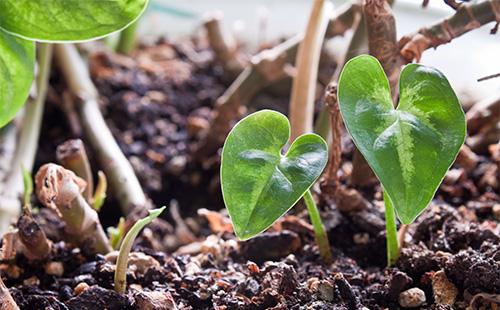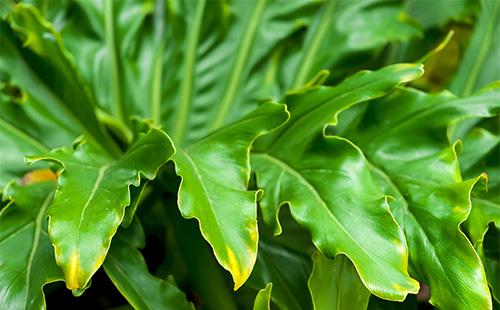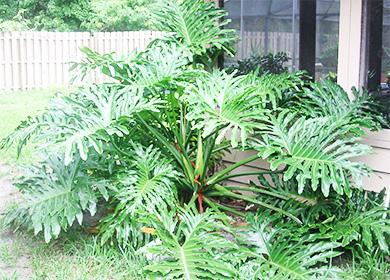The content of the article
The natural habitat of philodendron is South America and Mexico. It belongs to a large family of aroid. In the genus, there are about 400 varieties.
Botanical Description
Philodendron is an evergreen or semi-deciduous tropical perennial. Translated from Greek, the name sounds like "love a tree." It is connected with the peculiarity of the growth of the philodendron - with its aerial roots, it clings to the trees growing nearby, using them as a support. Vines with lignified or grassy stems predominate in the genus. Some varieties are distinguished by a powerful main stem, they can grow without additional support.
The size of the leaves, depending on the species, varies from 11 cm to 2 m. On the stem, they are arranged next to each other, have a different shape. Young leaves are heart-shaped in most varieties, as the structure grows. The upper side of the sheet is usually painted more intensely.
An interesting feature of the philodendron is two types of leaves on one plant. Ordinary leaves sit on elongated petioles, scaly - close the vegetative bud. For additional nutrition and fixation on a tree, the liana uses aerial roots. The processes for the extraction of food are long and thick, they reach the soil and take root in it next to the main stem. The roots for fixation are thinner and shorter, covered with villi.
In nature, light cob-shaped inflorescences with bedspreads of different colors are formed on the philodendron. In the cramped conditions of the apartment it is extremely rare to achieve flowering. Fruits - berries with small seeds.
Interesting varieties
There are many varieties of philodendron, but not all of them are suitable for home growing. Many species are suitable only for greenhouses and greenhouses. The names and characteristics of the most common indoor varieties can be found in the table.
Table - Popular varieties of philodendron
| Variety | Structure | Leaf shape and structure | Sheet length | Leaf color |
|---|---|---|---|---|
| Climbing Philodendron | Lianoid | - Heart-shaped leaves | 20-30cm | - Red tint in the newly opened leaves; - green - in adults |
| Philodendron Andre | - Lanceolate | 50–80 cm | - Green, with a light border and pronounced veins | |
| Philodendron decorated | - heart-shaped | 50-60 cm | - Emerald, with lighter blurry spots | |
| Philodendron blushing | - Triangular-ovoid | 20–25 cm | - Green, with a border of magenta | |
| Philodendron lobed | - Lobed, resembling a triangle | 45-50 cm | - intense green | |
| Philodendron Village | - Dissected | Sometimes reach meter | ||
| Philodendron guitar-shaped | - Guitar | No more than 30 cm | ||
| Philodendron Xanadu | Erect view up to 1.5 m tall | - Young leaves are oval; - adults - dissected | Up to 40 cm | |
| Philodendron Atom | Upright view with a shortened stalk | - Five-sided; - with wavy edges | 20-30 cm | |
| Philodendron | Lianoid | –– Slightly elongated; - with pointed ends | 15–25 cm | –– Dark green, with pronounced light spots of elongated shape |
Philodendron Care: Basic Rules
Philodendron is an easy-to-grow vine. But its tropical origin requires the creation of a certain microclimate in the room. How to care for the philodendron so that its foliage is large and beautiful? It is enough to follow a few simple rules.
- Lighting. The apartment finds a bright, but protected from the sun place. Liana can withstand slight shading, but can not grow in complete shade. The optimal location is the west and east side. From the south they put it at a distance from the window, from the north - they install additional lighting.
- Temperature. Philodendron grows well in moderate heat, at a temperature of 21–23 ˚С. It withstands a short increase to 28-30˚С. In winter, the temperature is reduced to 14–18 ˚С. During the dormant period, some varieties of philodendron partially discard leaves. In the spring they grow back.
- Humidity. Philodendron needs high humidity. Caring for it includes mandatory spraying, periodically wiping the leaves with a damp cloth. To further increase humidity, small containers of water are placed right in the pot next to the plant.
- Watering. Properly water the philodendron with warm, previously defended water. Stagnation of moisture in the root system is not allowed. Complete drying of the soil is also undesirable. Maintain stable earth moisture. According to experienced gardeners, philodendron can be grown hydroponically. In winter, watering is reduced, but not completely stopped.
- Top dressing. Use standard liquid fertilizers. They are brought in simultaneously with watering. It is enough to feed the philodendron twice a month. During the wintering, feeding is suspended.
- The soil. The plant is planted in neutral soil. From ready-made soil mixtures, soil mixtures for begonias or violets are selected. At home, the soil of the required acidity is prepared from peat, turf, deciduous land and sand.
- Transfer. Young specimens cross every spring, from three years of age - once every two years. There are difficulties with transplanting large vines in large containers - they update the top layer of the earth every year. They take into account the particularities of caring for the philodendron after transplantation - they water and spray it with Epin, and keep it in diffused light.

Breeding methods
You can propagate the philodendron with a stem cuttings, apex, air layers. The vegetative propagation method is used predominantly. Growing a full-fledged large vine from seeds takes a lot of time.
Cuttings
In spring, apical or stem cuttings with two to three leaves are cut. For cutting use a sterile, well-sharpened tool. Rooting is performed according to a certain pattern.
- Slices sprinkled with coal powder. Leave to dry for several hours.
- Small peat is mixed with perlite and sphagnum. The resulting substrate is poured into small pots and moisturized.
- Cuttings are buried in the soil by 3 cm. To create greenhouse conditions, the planted pieces of the stem are covered with banks. They put in a bright place, maintain a temperature of 25-30˚C.
- Once every two days, banks are removed. The soil is moistened, the cuttings are aired. After the appearance of new leaves, the shelter is removed.
Air layering
Propagation by air layering is an effective and reliable way. To obtain layering, choose healthy lignified stems. The procedure is performed in the following sequence.
- A circular incision is made on the stem.The bark is removed, the site of the cut is treated with Heteroauxin or Kornevin to stimulate root formation.
- Wrap with wet sphagnum. Fix the moss on the stem with a cling film.
- Moss moisten as it dries. Sometimes a small amount of root stimulant is added.
- Observe the formation of roots. The roots will be clearly visible through the cellophane film. They are allowed to grow a little, then the shoot is cut off along with the roots.
- Planted in a loose substrate. Maintain constant humidity, keep in a well-lit place.

Seeds
Growing philodendron from seeds will take longer. It is advisable to use only fresh seeds - they quickly lose their germination. To obtain healthy seedlings, the following planting scheme is followed.
- Pre-soaked seeds. Leave for eight to ten hours. It is advisable to use distilled water.
- Mix peat with sand. Fill the container with soil. Seeds are laid out on the surface. Do not bury and cover them with soil.
- The container is covered. Use a transparent lid or bag for this. Keep in a bright place. Maintain a temperature not lower than 28 ° C.
- Periodically, shelter is removed. The soil is moistened. The package is completely removed only after seed germination.
- Seedlings dive. Seedlings are planted in separate containers after the formation of three to four true leaves.
Common florist errors
As a result of improper care, the decorative effect of the philodendron is reduced. Often you have to deal with slow growth, yellowing, falling leaves. Typical errors and their consequences are described in the table.
Table - Common mistakes when growing philodendron
| Outward manifestation | Possible reasons | Solutions |
|---|---|---|
| The leaves fall and turn yellow | - root rot; - drying of soil | - Normalize watering mode; - when rotting is transplanted, cutting off damaged roots |
| Philodendron is growing slowly | - Heavy, dense soil; - hard irrigation water; - cold; - lack of food | - Transplanted into light soil; - water is preliminarily defended before watering; - increase the temperature of the content; - carry out extra feeding |
| Brown spots appear | - Sunburn; - contact with cold window glass | - Protect the philodendron from sun exposure; - in winter do not put the pot close to the glass |
| Edges and ends of leaves dry | - dry air | - Philodendron is regularly sprayed; - increase air humidity by any means |
| Foliage withers, droops, loses elasticity | - Lack of moisture in the soil | - Normalize watering mode |
| Drops of liquid gather on the leaves | - The normal process of removing excess moisture | - With the phenomenon characteristic of the philodendron, no measures are taken |
| Stems rot | - Excessive watering during the cool wintering period | - Watering reduce, dry the soil; - with severe decay, they trim, transplant the philodendron |

Diseases and Pests
Among diseases, root and stem rot is often found. Sometimes its development provokes a fungus, but much more often the reason lies in excessive watering and the lack of normal drainage. The treatment of rot consists in transplanting the plant with the removal of the affected roots and shoots. The plant is treated with drugs "Fitosporin", "Fundazole". In advanced cases, rooting of cuttings is carried out in case of death of the plant.
Faced with pests is much more common. Philodendron is affected by aphids, shields, spider mite, thrips. The table describes the signs of pest damage and how to get rid of them.
Table - Pests of philodendron
| Pest name | External manifestations | Methods of struggle |
|---|---|---|
| Aphid | - Tops with young leaves curl; - the leaves become sticky; - growth slows down | - Heavily damaged tops are cut off; - places of accumulation of insects are wiped with a soapy sponge; - twice sprayed with the insecticide "Aktara", taking a week break |
| Shields | - Small brown tubercles form; - sometimes leaves are covered with sticky drops; - the plant turns yellow, grows more slowly | - Scabbards are removed with a brush or alcohol wipe; - the most affected areas are wiped with alcohol; - sprayed with any insecticide |
| Spider mites | - Philodendron is covered with a thin web; - small bright spots appear on the leaves. | - Increase humidity in the room; - sprayed with the drug "Actara" |
| Thrips | - Leaves are covered with silver coating and black dots | - Liana is transplanted into new soil; - repeatedly with five-day intervals treated with the drug "Actellik" |
Growing philodendron at home is even for beginners. This unpretentious plant gratefully responds to proper care, not only decorating any interior of the apartment, but also making the air cleaner.

